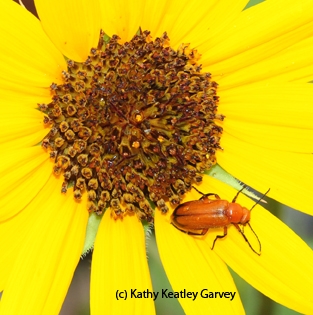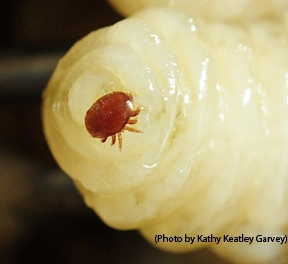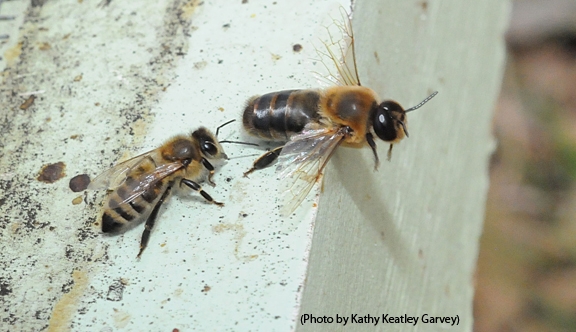
Teams of graduate or undergraduate students challenge one another in a college bowl-like competition about entomological facts, trivia and noted entomologists. You have to be quick. You have to know your insects, and that often includes the taxonomic rank of order, family, genus and species. And, you never know what the judges will ask you so you read, practice, read, practice, read, practice.
So, it was great to see our UC Davis Linnaean team--captain Ralph Washington, Jr., and members Jéssica Gillung, and Brendon Boudinot--win the regional championship at the recent Linnaean Games hosted by the Pacific Branch of ESA in Coeur d'Alene, Idaho. They'll be heading to Minneapolis in November to compete with other ESA branch winners in the national Linnaean Games. The Linnaean Games are named for Carl Linnaeus (1707-1778), the father of modern taxonomy.
Two of the questions asked--and quickly answered--by UC Davis at the Pacific Branch meeting, were:
What insect family can vector anthrax?
A. Tabanidae.
What caste of honey bee has the greatest number of ommatidia?
A. The drone, the male honey bee. Ommatidia are the subunits of a compound eye.

The UC Davis team, advised by Extension entomologist Larry Godfrey and Extension apiculturist Elina Nino, began practicing last December and met two hours a week.
As an undergraduate student, Ralph Washington Jr. helped anchor the UC Davis 2010 team that competed in the nationals in San Diego. UC Davis narrowly lost to Ohio State University, which advanced to the finals and then went on to win the championship.
Washington, Gillung and Boudinot are all systematists. Washington, whose major professor is nematologist Steve Nadler, studies mosquitoes; Boudinot studies ants with major professor Phil Ward, and Gillung studies flies with major professor Lynn Kimsey, who directs the Bohart Museum of Entomology. Gillung is co-advised by Shaun Winterton of the California Department of Food and Agriculture.
Washington, a first-year doctoral student from Sacramento, and the newly elected president of the UC Davis Graduate Student Association, focuses on how mosquitoes choose to lay their eggs, and how those choices affect their evolution.
Boudinot, a second-year doctoral student from Washington state, is known for his expertise on the morphology of male ants. He is also interested in the biogeography and evolutionary history of ants.
Gillung, a second-year doctoral student from Brazil, is a prominent taxonomist of Diptera (flies), with special emphasis on the diversity and evolution of spider flies, family Acroceridae. Some Acrocerid adults are specialized pollinators, while larvae are internal parasitoids of spiders.
The Pacific Branch of ESA encompasses 11 U.S. states (Alaska, Arizona, California, Hawaii, Idaho, Montana, Nevada, Oregon, Utah, Washington and Wyoming); several U.S. territories, including American Samoa, Guam and the Northern Mariana Islands; and parts of Canada and Mexico.
The trio is eagerly looking forward to making the 1900-mile trip from Davis to Minneapolis. Theme of the meeting is “Synergy in Science: Partnering for Solutions.” It will take place Nov. 15-18.
Some of the questions asked at previous national Linnaean Games:
1. Why do pineapple growers in Hawaii spray for ants?
A. The ants protect mealybugs from their natural enemies. Controlling the ants improves the effectiveness of natural enemies and reduces the transmission of mealybug wilt.
2. Fly fishermen follow the emergence of adults of various aquatic insects. What do typical fly fishermen call these emergence events and why is this entomologically wrong?
A. They call it a “hatch” which refers to emergence from the egg stage, not emergence of adults.
3. There are more than 2,600 species of termites worldwide. Which continent houses the most species?
A. Africa, which has over 1,000 species.
4. Give the common name and the family of the insects notorious for secretion of canthardin.
A. Blister beetles (Meloidae).
5. If you donate blood, you are asked about your exposure to babesiosis. What is the common name of the arthropod group that is the main vector of this disease?
A. Ticks
Attached Images:

The championship Linnaean Team, Pacific Branch of the Entomological Society of America: (from left) Jéssica Gillung, Brendon Boudinot, and Ralph Washington Jr. (Photo by Kathy Keatley Garvey)

A Linnaean Games question asked of the UC Davis team: What caste of honey bee has the greatest number of ommatidia? The answer is the drone, the male honey bee. Ommatidia are the subunits of a compound eye. This photo shows a worker bee or female (left) and a drone (right). (Photo by Kathy Keatley Garvey)